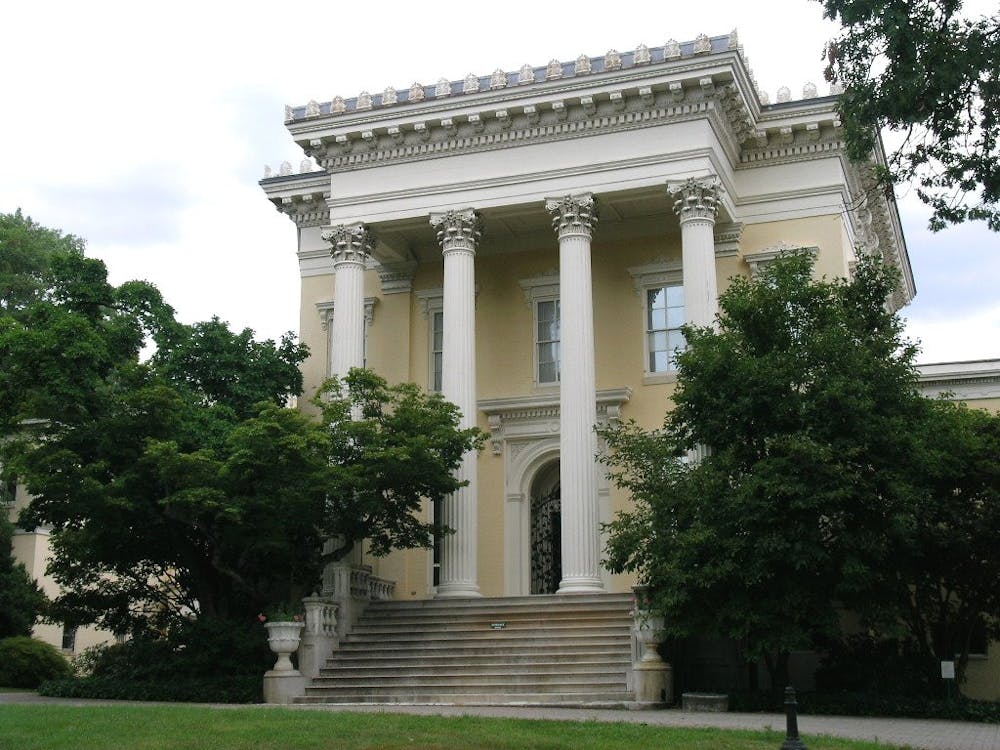Though pictures of the Evergreen Museum & Library make it seem like a reclusive, hard-to-find area of lush greenery in the middle of a bustling Baltimore, it is actually quite easy to access.
Part of our own university, the Evergreen Museum and Library was originally a Gilded Age mansion that was owned and maintained by the Garretts, a family from Baltimore. They owned the 17-acre property from 1878 to 1952. The mansion, classified as a classical and Renaissance revival, entered the family after being bought by President of the Baltimore and Ohio Railroad John W. Garrett. The Garretts’ riches came from their railroad business, with the Baltimore and Ohio Railroad becoming one of the most lucrative railroad companies in the United States.
The Garretts were known to be quite the collectors. In fact, they actually added a wing to their home that included a billiard room, a bowling alley and a gymnasium. That was later converted to an art gallery and a private theater — both of which are still in use. They owned the home until 1952, at which they donated the home to Hopkins. After being donated, the home was listed on the National Register of Historic Places in 1983.
The Garretts used their home to formulate an expansive collection of art that reflected their international travels, with pieces from China and Japan (in the red Asian room) and pieces from the renowned Pablo Picasso. Their library houses a stunning 30,000 volumes of literary works, with an especially strong presence of English Renaissance literature. Their vested interests in the arts led to their large collections of manuscripts and rare books, which can be seen if one decides to take the journey up to see them. Visitors can take advantage of the guided tours offered by the museum, or you can roam the halls that once housed the Garrett family here in Baltimore yourself.
So, the question must be lingering on your lips — how does one get to the Evergreen Museum? While the museum offers free parking and places to keep bicycles, I recommend utilizing the several public transport facilities offered in Baltimore.
The Baltimore City buses Route 51 and Route 28 go along the Charles Street entrance of the museum. However, these routes are subject to change, which is why I recommend going on the Collegetown Shuttle. As students, faculty or staff of the University, one can take the Collegetown Shuttle to stop 411, which is at Charles Street and Homeland Avenue. From this location, it is about a five-minute walk to the museum’s entrance.
As a person who is known to be apprehensive of public transportation, having never taken a bus before coming to Baltimore, I found it very easy to navigate my way up to the museum (it’s north of Homewood Campus, for those of you who like to be spatially aware). It is also accessible by Blue Jay Shuttle during the Night Ride!
As a history nerd (seen in my speech above of the origins of the museum), I was amazed by the various pieces of art and literature that emulated the rich experiences of the Garrett family. The museum is incredibly accessible, with pieces of Asian ceramics littering the halls and ensuring a different experience for all who walk inside. It is set up in a self-guided fashion barring your request for a tour, where you can wander through (by my estimate) 15 rooms in the Garrett mansion and glide through the lush grounds, pretending that you are a rich aristocrat.
The rooms are organized by themes, such as Asian ceramics and art, European pieces and even color palettes. The rich wood staircases with carved lions at the base and their stained glass windows made me feel as if I was observing a scene from Pride and Prejudice (the 2005 version, of course). The museum in and of itself is a representation of elaborate wealth and decadence, and the international origins of several of the pieces allow you to marvel at the true scope of the Garretts’ travels (and hope to go on your own someday).
My breath was absolutely blown away by the John Work Garrett Library, which is where my bibliophile self truly started to show. I love even just the sight of books, knowing that I probably will never be able to finish the 30,000 volumes contained within the library. However, just the sight of all of that knowledge, experience and creativity housed within those walls was truly exciting, if not slightly overwhelming.
I have to say, the main reason I loved the museum was that it allowed me to live out my fantasy of being a character in The Great Gatsby (you know, the ones that get invited to all of the parties but have no impact on the plot). You can explore the grounds to your heart’s desire and see the variations in the built and natural landscape. I probably liked the grounds more than the actual museum and library just because they complemented the rest of the museum so well and seemed to have a character of their own that endeared itself to me.
I had a brilliant time, and mentally I was able to destress by wandering through the various areas of art, books and greenery. There is something that everyone will enjoy, whether it is the quiet beauty and elegance of the library or the boastful expanse of the lawn. It’s a place to get lost in your thoughts and reflect on the origin of the pieces or your desire to be a protagonist in a Jane Austen novel (though that could just be me). And to make the deal even sweeter, you can access this amazing history and aesthetic landscape for free!





